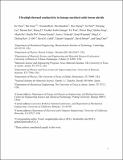Ultrahigh thermal conductivity in isotope-enriched cubic boron nitride
Author(s)
Chen, Ke; Song, Bai; Ravichandran, Navaneetha K.; Zheng, Qiye; Chen, Xi; Lee, Hwijong; Sun, Haoran; Li, Sheng; Udalamatta Gamage, Geethal Amila Gamage; Tian, Fei; Ding, Zhiwei; Song, Qichen; Rai, Akash; Wu, Hanlin; Koirala, Pawan; Schmidt, Aaron J; Watanabe, Kenji; Lv, Bing; Ren, Zhifeng; Shi, Li; Cahill, David G.; Taniguchi, Takashi; Broido, David; Chen, Gang; ... Show more Show less
Downloadultrahigh.pdf (5.275Mb)
Open Access Policy
Open Access Policy
Creative Commons Attribution-Noncommercial-Share Alike
Terms of use
Metadata
Show full item recordAbstract
Materials with high thermal conductivity (κ) are of technological importance and fundamental interest. We grew cubic boron nitride (cBN) crystals with controlled abundance of boron isotopes and measured κ greater than 1600 watts per meter-kelvin at room temperature in samples with enriched [superscript 10]B or [superscript 11]B. In comparison, we found that the isotope enhancement of κ is considerably lower for boron phosphide and boron arsenide as the identical isotopic mass disorder becomes increasingly invisible to phonons. The ultrahigh κ in conjunction with its wide bandgap (6.2 electron volts) makes cBN a promising material for microelectronics thermal management, high-power electronics, and optoelectronics applications.
Date issued
2020-01Department
Massachusetts Institute of Technology. Department of Mechanical EngineeringJournal
Science
Publisher
American Association for the Advancement of Science (AAAS)
Citation
Chen, Ke et al. "Ultrahigh thermal conductivity in isotope-enriched cubic boron nitride." Science 367, 6477 (January 2020): 555-559 © 2020 The Authors
Version: Author's final manuscript
ISSN
0036-8075
1095-9203